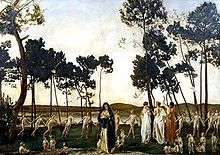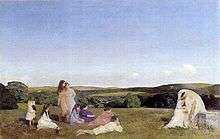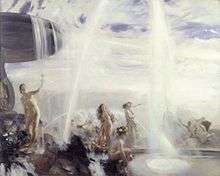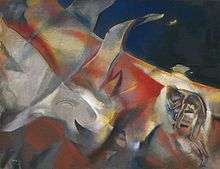Charles Sims (painter)
Charles Henry Sims RA (28 January 1873, Islington – 13 April 1928, St. Boswells) was a British painter of portraits, landscapes, and decorative paintings. Apart from his mainstream reputation, he is also considered an exponent of Outsider Art, as an artist whose work developed an idiosyncratic style through psychiatric disorder.




Biography
Born in Islington, London, Sims was the son of a costume manufacturer. Initially apprenticed in the drapery business, he moved to art in 1890 and enrolled at the South Kensington College of Art, before moving to Paris for two years at the Académie Julian. In the need of bursaries to support himself, he moved back to London and enrolled at the Royal Academy School in 1893. In 1895 he was expelled.
In 1897 he married Agnes, a daughter of the painter John MacWhirter.[1]
From 1896, he developed an increasingly successful career, first exhibiting The Vine at the Royal Academy in 1896, and selling another painting, Childhood to the Musée du Luxembourg. An expert at portraying sunlit landscapes, he specialised in society portraits and neo-classical fantasies, typically idealised scenes of women, children or fairies in outdoor settings.
In 1906 a one-man show at the Leicester Galleries brought him critical and financial success, allowing him to relocate to the rural Fittleworth. In 1910 he was elected a fellow of the Royal Watercolour Society, and in 1915 to the Royal Academy.
The First World War was a traumatic experience for Sims. In 1914, his eldest son was killed, and he worked for a time as a war artist in 1918. Post-war, his work changed track, and he began to develop religious and reclusive tendencies. He was upset at this time by criticism of his portrait of George V, which he destroyed. Despite receiving the honour of the keepership of the Royal Academy in 1920, he resigned and went to the United States to paint portraits, but became disgusted with society and abandoned portraiture in 1926.

His contribution to "The Building of Britain" series of historical paintings by various artists in St Stephen's Hall of the Palace of Westminster in London, commissioned in 1925 and unveiled in 1927, King John confronted by his Barons assembled in force at Runnymede gives unwilling consent to Magna Carta, the foundation of justice and individual freedom in England, 1215, attracted criticism from the press, Members of Parliament and other artists for its idiosyncrasy;[2] and The Introduction of Lady Astor as the First Woman Member of Parliament in 1919 had also been attacked on political grounds.
His final paintings, termed "Spirituals" (such as I am the Abyss and I am Light) featured naked figures against abstract apocalyptic backdrops. They were rejected by the artistic establishment for their baffling content and modernist style. In 1928, experiencing hallucinations, paranoia and insomnia, brought about by the horrific scenes he had witnessed as an official war artist and by his son's death, Sims committed suicide by drowning himself in the River Tweed near his home in St. Boswells, Scotland.[3]
Shortly after his death, the Royal Academy made the decision to exhibit posthumously some of his final works, which they termed "Mystical" for want of any other classification. The RA president, Sir Frank Dicksee, described them as "in marked contrast to all his previous work, and indicat(ing) a violent change of mentality".[4] A Times review of a further nine pictures from this period likened them to works of El Greco, "using his expedient of torn atmospheric forms for emotional purposes".[5]
Cultural references
A reference to Charles Sims and his work is made in Robert Aickman's story Ravissante, where his paintings are described as "apparently confused on the surface, even demented, they made one doubt while one continued to gaze, whether the painter had not in truth broken through to a deep and terrible order".[6]
References
- Simon Reynolds, "Sims, Charles Henry (1873–1928)", Oxford Dictionary of National Biography, Oxford University Press, 2004 accessed 27 June 2007
- John McWhirter, 'MacWhirter, John (1837–1911)', Oxford Dictionary of National Biography, Oxford University Press, 2004 accessed 26 May 2015
- Seel, Graham E. (July 2015). "The Artist and the King". History Today. 65 (7): 39–44.
- Compton Verney Archived October 25, 2007, at the Wayback Machine
- Mr. Sims's Last Pictures. Royal Academy Decision., New Phase Of Work, The Times, London, Apr 19, 1928
- Mr. Sims's "Mystical" Pictures, Review, The Times, London, May 02, 1928
- Old Earth Books, Robert R Chase, RevolutionSF
External links
- 65 paintings by or after Charles Sims at the Art UK site
- Tate Collection: Sims
- Henry Boxer Gallery: Sims
- Profile on Royal Academy of Arts Collections
![]()